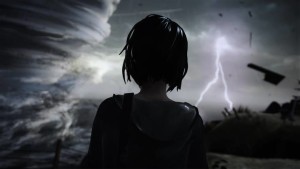Liverpool Sound and Vision Rating * * * * *
Life is Strange: Episode 5 – Polarized is a third-person episodic adventure game available for download from the PlayStation Store for the PS4. The episodic action of Life is Strange concludes with the fifth episode developed by Dontnod Entertainment who, having previously released Remember Me in 2013, are known for creating games with powerful and dependant female characters that grow and become stronger through the duration of the game.
The story of Episode 5 begins with a recap of the events that unfolded in the previous four episodes with the continuation of the story revolving around the lead character who following the thrilling and intensely emotional events of the first three episodes, the emotionally charged shocking cliff-hanger at the end of the fourth and who is now trying to find a way to adjust the events that have taken place to perfect the timeline in order to make things right and to help overcome the ominous incoming storm.
Max discovers that she can manipulate time by rewinding it in order to use the knowledge she has gained to her advantage in overcoming a situation by gaining answers to an important question or doing the opposite of the actions previously attempted and try to change the outcome of a bad scenario. Rewinding time can also help players to guide their actions in regards to the choices made and the consequences of those decisions, while it generally helps with a variety of puzzles and conversations.
A perfect example of this is when Max needs to help a fisherman who is in shock due to the severity of the storm over to the other side of a room as he will die from electrocution if Max turns the fuse box back on to start the sprinklers which she needs to do in order to put the flames out in the building, therefore Max switches the fuse box on as there is no other way to get to the fisherman, but then rewinds time resulting in her being able to keep him alive and move him out of the way before she turns the fuse box back on and provides the fisherman with a clear path to escape.
Further examples of Max’s abilities being put to the test include shortly afterwards when she has to save everyone in the diner by pouring sand in the way of a rapidly approaching fire, alongside a stealth section in which Max has to quietly navigate beyond a bunch of characters with flashlights who are looking for her. Max is able to rewind time to remain standing in the same spot as a character who found her is moved back to their previous location in order to provide a safe passage through the claustrophobic areas. This is an excellent design choice as it means that the standout mechanic of the game is not just a gimmick as it is actually used effectively which is quite easy to see that a genuine thought process has been invested in taking the time to implement scenarios that would fit well to the time manipulation element.
The Choices feature is quite reminiscent of the My Choices feature found in The Walking Dead episodic games by providing an entire listing of the choices including the statistical analysis regarding the percentage of players who have made the same decision and the percentage of those who have made a different one for each moral decision with the feature being directly available from the main menu.
There is a form of collectibles that are scattered throughout the episode in which Max can take a photo of a specific event such as a woman in an art gallery appreciating art or massively oversized squirrels looking at each other with a total of ten optional photos that players must be wary of encountering at any given moment within particular areas in order to find them. The optional photos are a positive design choice as it encourages a greater amount of exploration, but it is made even better by how players can return to any area of the episode in search of the optional photo that may have been missed without it interfering with the previously chosen decisions by playing in collectibles mode.
The supporting characters certainly change in their behavioural patterns and evolve more than ever throughout the duration of the fifth episode in comparison to the previous four individual episodes specifically due to the amount of wildly varying timelines being explored showing extremely altered personalities of almost every character, while the entire range of characters continue to be very unique in their personalities within the more regular timeline in regards to how they bully other people and having certain behaviour patterns such as being shy, sarcastic, aggressive, knowledgeable, talkative or friendly, while the male and female characters have their own diverse fashion styles that really set them apart in how they look as strong characters emerge throughout the story.
The environment design is as excellent and varied as the previous four episodes as the player explores Max’s hometown of Arcadia Bay in Oregon as it is being ravaged by the terrible storm with overturned cars, ruined buildings, fires spreading out of control, debris flying through the air and a whale in the middle of a road in what was once not only such a picturesque town but a peaceful community too.
There is also an art gallery and a surreal depiction of a tear in time itself in which Max experiences reoccurrences of scenes from previous episodes and even walks the hallways of the female dorm rooms as though she had just stepped into the terrifying P.T. in regards to repeating the same area but not always being entirely sure of what has changed since the last occasion it was explored, alongside a variety of other environments with every area throughout the game looking distinctly different which is a positive due to the variety of scenery that is provided across the environments.
The performance during remote play is just as excellent as the four previous episodes with the graphics, audio and general performance are all at the same level of quality as the PS4 version, while the control scheme has been appropriately optimised resulting in a comfortable control scheme during remote play as rewinding time has moved from L2 to the top left of the touch screen, while rewinding time faster has switched from R2 to L and moving faster has moved from R2 to the top right of the touch screen, although it would have perhaps been better suited to the R button instead, alongside tapping the touch pad to open Max’s journal has been mapped to the touch screen and R3 has been mapped to the rear touch pad to re-centre the camera.
The controls are well mapped to the DualShock 4 controller with the control scheme consisting of pressing triangle, O, X or square to perform contextual actions; holding L2 to rewind time while holding R2 to rewind time faster, holding R2 to move faster, pressing R3 to re-centre the positioning of the camera, changing the direction of the left analogue stick to move Max, changing the direction of the right analogue stick to move the camera, pressing the share button takes the player to the share feature menu and pressing the options button to display the pause menu. The touch pad implementation displays Max’s journal by tapping the touch pad, while the light bar implementation remains a light shade of orange throughout gameplay and menus, alongside vibration that is scattered throughout the game for heavy objects falling, loud noises or focusing in on photos.
The graphics have quite a stylistic approach to rewinding time comprising of such special visual effects as overlapping screen space particles, double exposure and post-processes to create a very unique look that captures the imagination as to exactly what the eyes would see during time travel and time manipulation, while the lighting and shadows are utilised with incredible effect during the surreal nightmare scenes and particle effects during the storms are amazing with lightning strikes and debris being thrown through the air, alongside superb character models with fluent and natural character movements, although the lip syncing still does not quite match the voice-overs for the majority of the characters and lines of dialogue.
The presentation of the game is solid with a great user interface across various menus such as the main, episodes, help & options, additional content and gameplay menus with support for navigation via the left analogue stick, directional pad and face buttons, although it does not include support for navigation via the right analogue stick and touch pad. The background of the menu screens are nowhere near as tranquil as the majority of previous episodes as they depict an extreme storm with a hurricane bearing down on Arcadia Bay as lightning strikes around the vicinity as debris flies through the air.
The voice-over cast deliver exceptional performances with realistic dialogue to the age range of each character which if anything makes each of the characters even more diverse rather than too serious during light hearted moments or one dimensional.
No new characters are introduced into the fifth episode, although there is continuity of characters and the performances maintain the same high standards as previous episodes including Hannah Telle delivering an amazing performance as the lead character Maxine Caulfield having previously voiced Iris Campbell and Rose Campbell in Murdered: Soul Suspect, while Ashly Burch voices Chloe Price having also voiced Ayla in Awesomenauts, Tiny Tina in Borderlands 2 and Cassie Cage in Mortal Kombat X. Former X Factor USA finalist Dani Knights voices Victoria Chase, Derek Phillips voices Max’s photography teacher Mark Jefferson, having previously voiced Lord Treavor Pendleton in Dishonored and Officer Scott and Kurt Wehlander in Murdered: Soul Suspect. Don McManus voices David Madsen who has appeared in such films as The Shawshank Redemption, The 6th Day and National Treasure and Cissy Jones as Joyce Price having voiced Katjaa in The Walking Dead: Season 1, Shel and Dee in The Walking Dead: 400 Days, as well as Joe Ochman voicing Chloe’s father William Price having previously voiced Jiminy Cricket in Kingdom Hearts HD 2.5 Remix, Elyson in Dragon’s Dogma, Professor Howard MacDougal and a Government Clerk in Red Dead.. There are many more talented voice-over artists such as Dayeanne Hutton as Kate Marsh and Alyssa Anderson, Carlos Luna as Warren Graham, Nik Shriner as Nathan Prescott, Daniel Bonjour as Frank Bowers and Eric Morgan Stuart as Principal Ray Wells.
The sound effects include Max as well as other characters walking, running and generally interacting with their surroundings and nearby people, while there is just as much ambience in comparison to the four previous episodes such as birds tweeting, a barking dog and the reaction of people around Max as they go about their everyday lives, while the amazing soundtrack consists of hand picked indie music from rock to melodic acoustic ballads which perfectly set the tone and atmosphere of the scenes they accompany from artists such as Foals, Mud Flow, Syd Matters and Voy Fo Lla oT with the score composed by Jonathan Morali of Syd Matters which can be heard in the main menu and credits. There is no DualShock 4 speaker implementation which is surprising as it could have produced voice-overs, sound effects, ambient sound effects or music to provide a further layer of audio.
The trophy list for the fifth episode includes 11 bronze, 1 gold and 1 platinum trophy if all of the trophies from the previous four episodes have already been earned with the complete trophy list featuring 61 trophies with 59 bronze trophies, 1 gold trophy and 1 platinum trophy. The trophies are all pretty simple for the fifth episode as long as players know the mechanics of the game as they have to take 10 optional photos which will provide 11 trophies such as the Incandescent bronze trophy for taking optional photo #1 of Kate in the classroom after Max has comforted her, while the Polarized gold trophy is awarded for completing the fifth episode and the remaining What If platinum trophy will be achieved when having completed all five episodes and taken all 50 of the optional photos throughout the five episodes. It is estimated that depending upon skill and a good trophy guide to provide some helpful tips that it would take between 2 to 3 hours to 100% the fifth episode and 10 to 15 hours to platinum the trophy list.
There are no difficulty levels but there is a rather fitting difficulty curve as there are plenty of puzzles to solve which are related to rewinding time, resulting in the difficulty curve being the equivalent to how quickly the player can adapt to the time manipulation mechanics. There will most probably be a few puzzles that may not be initially obvious in regards to what is required in order to solve them, but with some experimenting players will work out the requirements of the puzzles within a few minutes.
There are no online leaderboards and no local or online multiplayer, although players should not really expect a multiplayer component in something that is as story and character driven as Life is Strange. However, despite there being no online leaderboards there is a statistical analysis of the decisions that have been made throughout the duration of the episode in comparison to the decisions that everyone else across the world and friends who have played the fifth episode of Life is Strange have made, which is a positive design choice in the sense that it provides the player with an in depth look at if the correct or incorrect decision in comparison to other players has been made. Every decision within the fifth episode is clearly defined in the statistical analysis and it is incredibly interesting to seeing which percentage of players made the same decisions as and to also see the percentage of players that chose to go in an opposite direction.
The replayability of the game revolves around the excellent story and strong developing characters, while the unpredictability of how situations will play out given that the outcome can be changed by experimenting with rewinding time which will collectively have the player going beyond the initial playthrough consisting of two to three hours worth of gameplay for the fifth episode to see how differently scenarios can play out and people can react to decisions and approaches to conversations with the further addition of an alternative ending.
Overall, the fifth episode of Life is Strange maintains the pace and delivers just as much exceptional quality throughout from story telling to character progression and some thoughtful puzzles culminating in an emotionally gripping epic conclusion with two endings to choose from that are both appropriate finales to the four episodes which preceded it in what is one of the greatest episodic videogame stories of all time which everyone absolutely has to experience.
Jason Bonnar
Analysis
- Title: Life is Strange: Episode 5 – Polarized
- Developer: Dontnod Entertainment
- Publisher: Square Enix
- System: PS4
- Format: PSN Download
- Cross-Buy: No
- Cross-Play: No
- Players: 1
- Hard Drive Space Required: 3.3GB (Episode 5)/5.75GB (Episodes 1 and 5 – Version 1.06)


